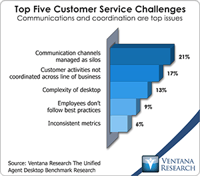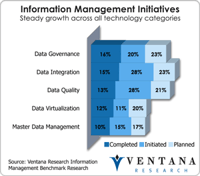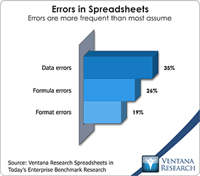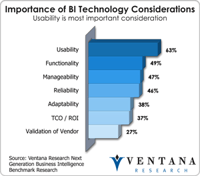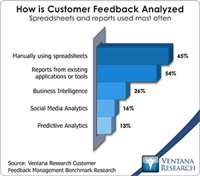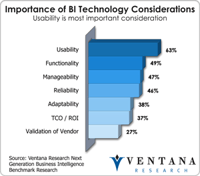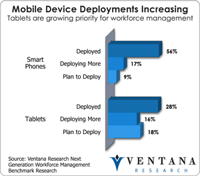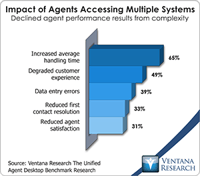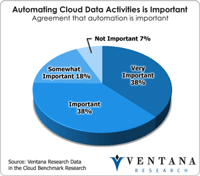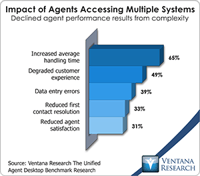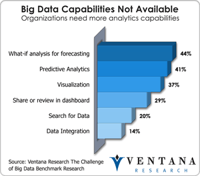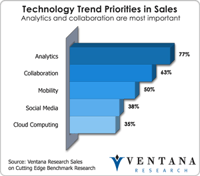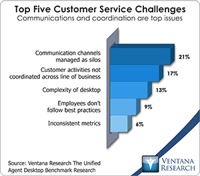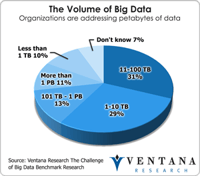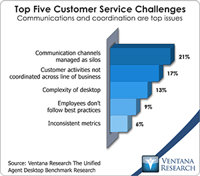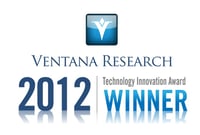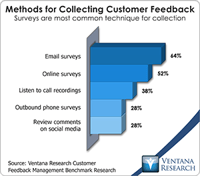Managing payroll has long been viewed as an administrative task, time-consuming and focused on ensuring that everyone is paid correctly and on time. In fact, in the American Payroll Association’s most recent annual study, the main metrics tracked for payroll performance are payroll cost per employee, payroll processing accuracy rate and dollar value of overpayments – all of which focus only on cost or accuracy. So payroll management is rarely viewed as having any strategic value to the business...
Read More
Topics:
HCM,
Human Capital Management,
Office of Finance,
IT Research,
Cloud Computing,
Information Applications,
Workforce Performance,
TCM
I recently wrote how Enghouse Interactive is building a portfolio of products to support contact center in the cloud. The foundation of all its products is the handling of interactions through a comprehensive set of communication channels. My research into the contact center in the cloud shows that after the adoption of CRM in the cloud, companies are most likely to adopt contact centers in the cloud because they support consumers that want to interact through more channels, and because of the...
Read More
Topics:
Customer Experience,
Enghouse interactive,
Analytics,
Cloud Computing,
Customer & Contact Center,
Customer Service,
Call Center,
Contact Center,
Contact Center Analytics,
CRM,
Unified Communications
The proper use of technology enables businesses to be more efficient. Our recent research into technology for business innovation found that 56 percent indicate innovative technology is very important, yet only 9 percent are very satisfied with theirs, showing plenty of room for improvement. As we enter 2013, businesses have more choices than ever for technology to improve business and IT. Our firm has identified six key technologies that give organizations significant competitive advantages:...
Read More
Topics:
Big Data,
Sales Performance,
Social Media,
Supply Chain Performance,
Mobile Technology,
Social Collaboration,
IT Performance,
Operational Performance,
Business Analytics,
Business Collaboration,
Business Intelligence,
Business Performance,
CIO,
Cloud Computing,
Customer & Contact Center,
Financial Performance,
Governance, Risk & Compliance (GRC),
Information Applications,
Information Management,
Location Intelligence,
Operational Intelligence,
Workforce Performance,
CMO,
COO,
CTO
Banking giant JP Morgan raised eyebrows in 2012 when it revealed that it had lost a substantial amount of money because of poorly conceived trades it had made for its own account. The losses raised questions about the adequacy of its internal controls, and broader questions about the need for regulations to reduce systemic risk to the banking system. At the heart of the matter were the transactions made by “the London Whale,” the name given to a JP Morgan’s trading operation in the City by its...
Read More
Topics:
Sales,
Sales Performance,
GRC,
Office of Finance,
error,
Operational Performance,
Business Analytics,
Business Collaboration,
Business Intelligence,
Business Performance,
Financial Performance,
Information Management,
Data,
controls
I hadn’t come across Vertical Solutions until a recent briefing, from which I found that the company offers an interesting combination of field service management and CRM. Vertical Solutions has offices around the world, and its target market is companies with between 50 and 2,500+ users in the manufacturing, outsource contact center services, healthcare and residential services markets. It began with a focus on field service and has expanded to include CRM, or, as I would call it, customer...
Read More
Topics:
Social Media,
Customer Experience,
Voice of the Customer,
Mobile Apps,
Self-service,
Analytics,
Cloud Computing,
Collaboration,
Customer & Contact Center,
Customer Service,
Call Center,
Contact Center,
CRM,
Vertical Solutions
HireVue has announced the release of a new add-on module for its HireVue Digital Interview Platform. CodeVue is intended to improve the way organizations identify, screen and assess technical or developer positions. Potentially it will benefit companies that need to fill large numbers of technical positions that involve writing code, helping to automate a recruiting process that has been manual and inefficient.
Read More
Topics:
Social Media,
Cloud Computing
Actuate this week announced BIRT Analytics, and thereby puts itself firmly into supporting a range of business analytics needs from data discovery and visualization to a range of data mining and predictive capabilities that allows itself new avenues of growth. Actuate has long been a staple of large Business Intelligence deployments; in fact the company claims that ActuateOne delivers more insights to more people than all other BI applications combined. This is likely true, given that Actuate...
Read More
Topics:
Data Scientist,
Operational Performance,
Analytics,
Business Analytics,
Business Intelligence,
Business Performance,
CIO,
Financial Performance,
Information Applications,
Operational Intelligence,
Data Discovery,
commodity model,
Quinterian
Recently Verint announced a new development in its workforce optimization suite Impact 360 Workforce Optimization that it calls Personalized Guidance. It aims to improve the customer experience by prompting anyone handling customer interactions with what they should do next. The principle is simple and logical: Analyze all the data you can so you understand the customer and context of the interaction, identify best next action, and prompt the person handling the interaction with this action so...
Read More
Topics:
Customer Analytics,
Customer Experience,
Speech Analytics,
Voice of the Customer,
Operational Performance,
Analytics,
Customer & Contact Center,
Customer Service,
Call Center,
Contact Center,
Contact Center Analytics,
CRM,
Desktop Analytics,
Text Analytics,
Verint,
Workforce Force Optimization
The majority of companies think it is important to collect customer feedback, according to my recent research into customer feedback management, and they put that feedback to an average of five uses, the top five of which are to improve customer service (75%), to develop customer experience and interaction processes (54%), to identify agent training needs (54%), to improve products (50%) and to create a customer service strategy (49%).
Read More
Topics:
Customer Analytics,
Customer Experience,
Customer Feedback Management,
Speech Analytics,
Voice of the Customer,
Analytics,
Customer & Contact Center,
Customer Service,
Call Center,
Contact Center,
Contact Center Analytics,
CRM,
Desktop Analytics,
Text Analytics
SAP just released strong preliminary quarterly and annual revenue growth, which in many ways can be attributed to a strong strategic vision around the HANA in-memory platform and strong execution throughout the organization. Akin to flying an airplane while simultaneously fixing it, SAP’s bold move to HANA may at some point see the company continuing to fly when other companies are forced to ground parts of their fleets.
Read More
Topics:
Sales,
Sales Performance,
SAP,
Supply Chain Performance,
Business Objects,
Business Objects predictive analytics,
Crystal reports,
Operational Performance,
Visi,
Analytics,
Business Analytics,
Business Collaboration,
Business Intelligence,
Business Performance,
Cloud Computing,
Customer & Contact Center,
Financial Performance,
IBM,
Operational Intelligence,
Workforce Performance,
cognos insight,
SAP predictive analytics,
Sybase IQ
Human capital is most organizations’ largest investment and one of their largest differentiators against the competition. So it follows that those that take advantage of the compelling, game-changing technology now available in human capital management (HCM) will place themselves at a competitive advantage.
Read More
Topics:
Big Data,
Social Media,
HCM,
Human Capital Management,
Learning,
Office of Finance,
Social Collaboration,
Analytics,
Business Analytics,
Business Collaboration,
Business Intelligence,
Business Performance,
Cloud Computing,
Information Applications,
Information Management,
Workforce Performance,
CFO,
Compensation,
finance,
HR,
Talent Management,
Workforce Management
My recent benchmark into the unified customer service agent desktop shows how critical the agent desktop is to improving agent satisfaction, meeting key customer-related metrics and enhancing the customer experience. The typical agent desktop contains multiple systems that allow agents access to multiple communication channels, business applications, messages and performance dashboards. The result is that the desktop is cluttered with systems, frustrating agents, driving up average interaction...
Read More
Topics:
Sales Performance,
Customer Experience,
Voice of the Customer,
Operational Performance,
Analytics,
Cloud Computing,
Collaboration,
Customer & Contact Center,
Customer Service,
Call Center,
Cisco,
Contact Center,
CRM,
Upstream Works,
Workforce Force Optimization
Managing the access, storage and use of data effectively can provide businesses a competitive advantage. Last year I outlined what the big deal is in big data, as the initial focus on the volume, velocity and variety of data – what my colleague Tony Cosentino calls the three V’s – is only one small piece of how organizations should evaluate this technology. The more balanced approach is to include what he calls the three W’s – the what, so what and now what, which shifts the focus to an...
Read More
Topics:
Big Data,
Master Data Management,
Predictive Analytics,
Sales Performance,
MDM,
Operational Performance,
Business Analytics,
Business Intelligence,
Business Performance,
CIO,
Cloud Computing,
Data Governance,
Data Integration,
Financial Performance,
Information Applications,
Information Management,
Location Intelligence,
Operational Intelligence,
Product Information Management
My research into the customer service agent desktop shows that most centers expect a lot of their contact center agents: more than half (59%) handle between two and five different services (such as general queries, complaints and sales) and 14 percent handle seven or more. Nearly half (49%) are expected to handle between six and 15 calls per hour, and as well as calls, the majority (75%) are expected to handle other forms of interactions, with most handling between one and five per hour. To...
Read More
Topics:
Sales Performance,
Social Media,
Customer Analytics,
Customer Experience,
Speech Analytics,
Voice of the Customer,
Operational Performance,
Analytics,
Business Collaboration,
Cloud Computing,
Collaboration,
Customer & Contact Center,
Customer Service,
Call Center,
Contact Center,
Contact Center Analytics,
CRM,
Desktop Analytics,
Text Analytics
Did you catch all the big data analogies people used in 2012? There were many, like the refinement of oil analogy, or the spinning straw into gold analogy, and less useful but more entertaining ones, like big data is like a box of chocolates, or big data is like The Matrix (because “there’s no way Keanu Reeves learns Kung Fu in five seconds without using big data”). I tend to like the water analogy, which I’ll use here to have a little fun and to briefly describe how I see the business...
Read More
Topics:
Big Data,
Sales Performance,
Social Media,
Supply Chain Performance,
IT Performance,
Operational Performance,
Analytics,
Business Analytics,
Business Collaboration,
Business Intelligence,
Business Performance,
CIO,
Cloud Computing,
Customer & Contact Center,
Financial Performance,
Governance, Risk & Compliance (GRC),
Information Applications,
Information Management,
Location Intelligence,
Operational Intelligence,
Workforce Performance,
Data
Hi; pleased to meet you! I’m tremendously excited to be joining the team here at Ventana Research, and I’m looking forward to adding my experience, observations and opinions to this team of very talented industry analysts! Let me start by telling you a little about my background, and then why a chose to come to work here and what I will be covering at Ventana Research.
Read More
Topics:
Social Media,
Human Capital Management,
Market Research,
Office of Finance,
Business Collaboration,
Business Performance,
Cloud Computing,
Information Management,
Workforce Performance,
HR,
Talent Management,
Workforce Management
At the beginning of 2012 Ventana Research predicted that six major technologies would have an impact on the provision and supply of IT systems, and that these would bring about innovation in the way organizations support their business. Each of the six – business and social collaboration, mobile, analytics, cloud computing, social media and big data – has affected how organizations engage with their customers, but I don’t believe the full impact has yet been fully realized. Indeed, in some...
Read More
Topics:
Social Media,
Customer Analytics,
Customer Experience,
Customer Feedback Management,
Social CRM,
Speech Analytics,
Voice of the Customer,
Mobile Apps,
Analytics,
Business Analytics,
Business Collaboration,
Cloud Computing,
Collaboration,
Customer & Contact Center,
Customer Service,
Call Center,
Contact Center,
Contact Center Analytics,
CRM,
Desktop Analytics,
Text Analytics,
Unified Communications,
Workforce Force Optimization
Most organizations see improving the effectiveness of sales as a way to increase productivity. Those organizations that take advantage of the latest sales applications and technology are finding themselves with a competitive advantage, but many organizations lack the time and resources to assess and deploy appropriate platforms. That’s a shame, since most sales organizations have plenty to improve in their selling, forecasting, incentives and planning according to our latest research on sales...
Read More
Topics:
Sales,
Sales Performance,
Marketing,
PIM,
Sales Compensation,
Sales Forecasting,
Operational Performance,
Business Performance,
Financial Performance,
CPQ,
CRM,
Product Information Management,
SFA
Read More
Topics:
Mobile,
Predictive Analytics,
Real-time,
Sales Performance,
SAP,
Supply Chain Performance,
ERP,
Operational Performance,
Analytics,
Business Analytics,
Business Collaboration,
Business Performance,
Cloud Computing,
Customer & Contact Center,
Financial Performance,
In-memory,
Workforce Performance,
CRM,
finance,
Social,
Business Suite,
Financial Performance Management,
HANA
Despite the recession, 2012 was a busy year in the contact center, customer service and customer experience markets. Ventana Research completed four benchmark research studies into customer relationship maturity, contact center in the cloud, customer feedback management and agent desktop. Overall these show that organizations are slowly maturing in the processes, people, information and technology they use to support customer-facing activities. However, they also show many of the old issues...
Read More
Topics:
Social Media,
Customer Analytics,
Customer Experience,
Customer Feedback Management,
Social CRM,
Speech Analytics,
Voice of the Customer,
Mobile Apps,
Operational Performance,
Analytics,
Business Analytics,
Business Collaboration,
Cloud Computing,
Collaboration,
Customer & Contact Center,
Customer Service,
Call Center,
Contact Center,
Contact Center Analytics,
CRM,
Desktop Analytics,
Text Analytics,
Unified Communications,
Workforce Force Optimization
Businesses always see a lag between when technology makes some advance possible and when a majority of companies actually adopt it. There’s even a longer lag between the emergence of an advance in a business process or technique and the time it takes to become mainstream. When we write our research agendas at the top of each year, we have to strike a balance between focusing on the new and different, which is still many years away from general acceptance, and the mainstream, which has been...
Read More
Topics:
Big Data,
Planning,
Predictive Analytics,
Sales Performance,
Governance,
GRC,
Office of Finance,
Budgeting,
close,
Operational Performance,
Analytics,
Business Analytics,
Business Collaboration,
Business Performance,
CIO,
Cloud Computing,
Financial Performance,
Governance, Risk & Compliance (GRC),
In-memory,
Workforce Performance,
CFO,
Risk,
CEO,
Financial Performance Management,
FPM
In early 2012 I wrote a blog post about how Verint was overcoming some of its product integration issues by using an information-driven approach that allows users to drill down from key performance metrics into underlying application data. The latest version of its Impact 360 Workforce Optimization suite extends this approach and supports a flow of data between applications and workflows that enables cross-application processes. The suite of products includes interaction recording, workforce...
Read More
Topics:
Customer Analytics,
Customer Experience,
Customer Feedback Management,
Social CRM,
Speech Analytics,
Voice of the Customer,
Analytics,
Customer & Contact Center,
Customer Service,
Call Center,
Contact Center,
Contact Center Analytics,
CRM,
Desktop Analytics,
Text Analytics,
Verint,
Workforce Force Optimization
Revolution Analytics is a commercial provider of software and services related to enterprise implementations of the open source language R. At its base level, R is a programming language built by statisticians for statistical analysis, data mining and predictive analytics. In a broader sense, it is data analysis software used by data scientists to access data, develop and perform statistical modeling and visualize data. The R community has a growing user base of more than two million worldwide,...
Read More
Topics:
Big Data,
SAS,
IT Performance,
Operational Performance,
Business Analytics,
Business Intelligence,
Business Performance,
Cloud Computing,
Information Management,
Operational Intelligence,
SPSS
In today’s competitive markets, many organizations recognize that customer service represents an opportunity to differentiate themselves from their competition. However, our research into the agent desktop shows that providing excellent customer service is a real challenge in many areas, starting with managing the channels of communication required to offer customers a choice in how they interact with the company. My research into customer and contact centers shows that over the last 18 months,...
Read More
Topics:
Sales Performance,
Customer Analytics,
Customer Experience,
Voice of the Customer,
Operational Performance,
Analytics,
Business Performance,
Customer & Contact Center,
Customer Service,
Call Center,
Contact Center,
Contact Center Analytics,
CRM
Happy New Year to all my readers and followers. I hope everyone has gotten some rest and is ready for a great 2013. 2012 was a busy year in which we saw a critical inflection point, where an elevated focus on new methods and innovative technological approaches such as big data, business analytics, business and social collaboration, cloud computing, mobile technology and social media become part of the mainstream business and IT dialogue. These technologies are beginning to be part of or...
Read More
Topics:
Big Data,
Sales Performance,
Social Media,
Supply Chain Performance,
Market Research,
Mobile Technology,
Social Collaboration,
IT Performance,
Operational Performance,
Business Analytics,
Business Collaboration,
Business Intelligence,
Business Mobility,
Business Performance,
CIO,
Cloud Computing,
Customer & Contact Center,
Financial Performance,
Information Applications,
Information Management,
Location Intelligence,
Operational Intelligence,
Workforce Performance,
Technology
Customers have always been important to companies, but what are the best metrics to measure the success of customer-related activities, and how well companies meet customer expectations?
Read More
Topics:
Customer Analytics,
Customer Feedback Management,
Speech Analytics,
Voice of the Customer,
Analytics,
Business Analytics,
Customer & Contact Center,
Contact Center Analytics,
Desktop Analytics,
Text Analytics
It’s hard to believe that Salesforce.com was launched only 14 years ago. It has since grown into a multi-billion-dollar company that has changed the way companies source software. Back in the early days its two primary messages were “the end of on-premises software” and “a new era of CRM in the cloud.” Today the first message seems to have softened somewhat, with its own website talking about products and applications, and of course many companies still use traditional on-premise applications....
Read More
Topics:
Salesforce.com,
Social Media,
Customer Analytics,
Customer Experience,
Social CRM,
Voice of the Customer,
Mobile Apps,
Analytics,
Business Analytics,
Business Collaboration,
Cloud Computing,
Collaboration,
Customer Service,
Call Center,
Contact Center,
Contact Center Analytics,
CRM
Ventana Research has been researching and advocating operational intelligence for the past 10 years, but not always with that name. From the use of events and analytics in business process management and the need for hourly and daily operational business intelligence, but its alignment with traditional BI architecture didn’t allow for a seamless system, so a few years later the discussion started to focus around business process management and the ability of companies to monitor and analyze BPM...
Read More
Topics:
Big Data,
SOA,
Supply Chain Performance,
business activity monitoring,
business process monitoring,
IT Performance,
Operational Performance,
Analytics,
Business Analytics,
Business Intelligence,
Business Performance,
Complex Event Processing,
Customer & Contact Center,
Operational Intelligence,
Service Cloud
As I’ve noted before, it’s common for CFOs of companies that are transitioning from being a small to a midsize business (that is, when they grow past about 100 employees) to find that the entry-level accounting package that they have been using no longer fits their needs. This software may be inexpensive to purchase and easy to use but it lacks many of the customization and business process management capabilities that become increasingly important as organizations grow. The transition from...
Read More
Topics:
Planning,
Salesforce.com,
ERP,
Human Capital Management,
Office of Finance,
Reporting,
close,
closing,
Operational Performance,
Business Performance,
Cloud Computing,
Financial Performance,
Workforce Performance,
Financial Performance Management,
FinancialForce.com
Many organizations collect customer feedback, but my recent research into customer feedback management shows that most have yet to take advantage of modern techniques. The research shows that companies on average use approximately four methods. The most popular remain email and online surveys, listening to call recordings and outbound phone calls. Newer techniques such as reviewing social media posts, social media forums, mobile apps and mobile text-based conversations remain the domain of...
Read More
Topics:
Customer Analytics,
Customer Experience,
Customer Feedback Management,
Voice of the Customer,
Analytics,
Cloud Computing,
Customer & Contact Center,
Customer Service,
Call Center,
Contact Center,
Contact Center Analytics,
CRM,
Text Analytics


